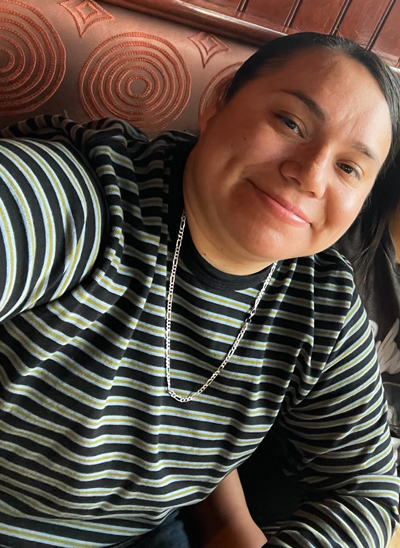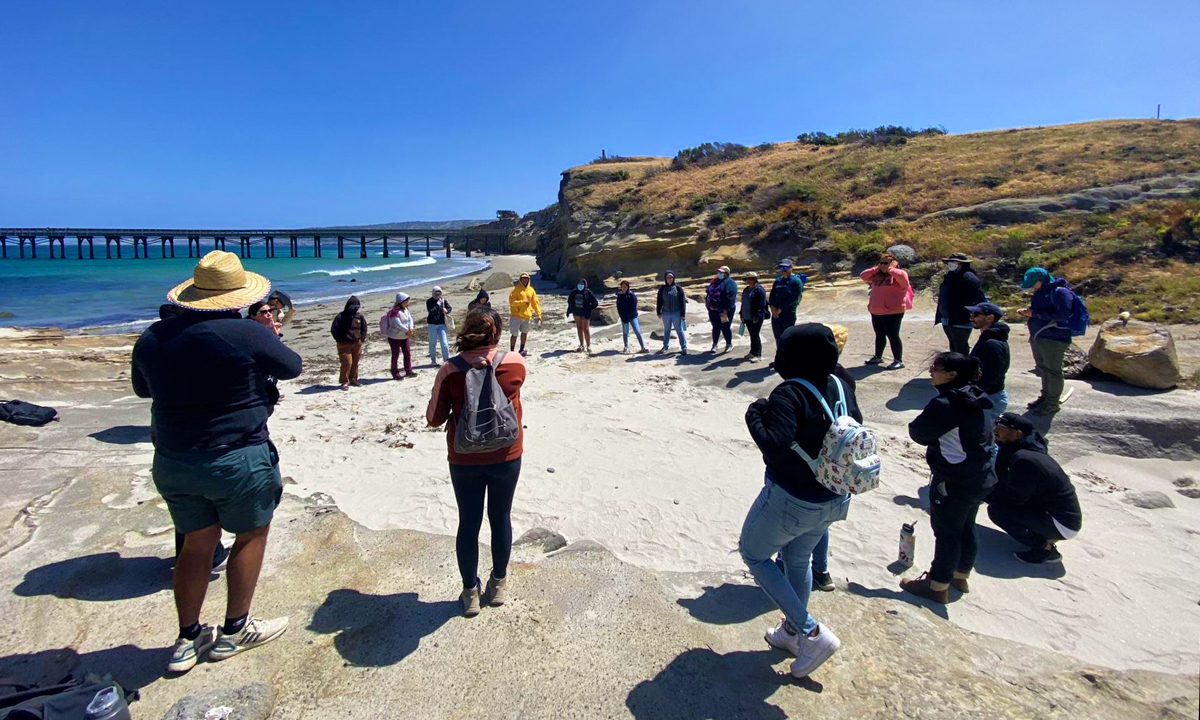In fall 2021, the California State University announced five new
Graduation Initiative 2025 priorities aimed at
eliminating graduation rate equity gaps that affect underrepresented students. Since then, CSU campuses have implemented steps to address each of those goals:
- Reengage and reenroll underserved students
- Expand credit opportunities with summer/intersession
- Ensure equitable access to digital degree planners
- Eliminate administrative barriers to graduation
- Promote equitable learning practices and reduce DFW (D-F-Withdraw) rates
This third installment in the five-part series focuses on how CSU campuses are eliminating administrative barriers to graduation, efforts that are closely tied to the other priorities, especially
reenrollment efforts and summer credit opportunities.
“Most of our students are first-generation, and a lot of our students have been told over and over that, educationally, they're not good enough,” says Lesley Davidson-Boyd, Ph.D., associate vice president of Academic Success & Undergraduate Advising at
California State University, San Bernardino. “Part of removing the barriers is taking out this layer that implies they don't know the right way to do things, so they don't belong here. Removing the barriers creates an environment that feels more inclusive.”
A Second Chance
Airam Quiroa only needed one more semester to graduate from Cal State San Bernardino. But after leaving mid-semester in 2020 to care for her father, she began accumulating debt from the dropped courses and forgetting to disenroll from her summer courses. Paying it off proved too much an obstacle to returning.
 “When they advised me that I did qualify [for debt relief], I was really excited because a lifelong 12-year school career was finally coming to end.” —Airam Quiroa
“When they advised me that I did qualify [for debt relief], I was really excited because a lifelong 12-year school career was finally coming to end.” —Airam Quiroa
With the help of the
Educational Opportunity Program (EOP), Quiroa found she qualified for CSUSB’s reenrollment effort aimed at eliminating the biggest barrier to students’ returning to school: debt and financial registration holds.
Through the spring 2022 reenrollment campaign, CSUSB paid off outstanding debts using the Higher Education Emergency Relief Fund (HEERF) for students in good academic standing. Returning students who received the debt forgiveness were required to take two classes in the summer—paid for by the university—and register for the following fall.
“I couldn't enroll in summer this year without that debt being wiped out or taken care of, and that would’ve stopped me from fall as well,” Quiroa says. “Then the fact I was able to join summer allowed me to complete courses so I can hopefully graduate in December. ... I felt an inspiration to finish now because December sounds a lot closer than next year.”
This fall, Quiroa plans to take classes to finish her sociology degree, as well as some courses to boost her GPA, in hopes of going into a counseling and guidance master’s program.
“If I didn't have this opportunity, it would've set me back another year or a year and a half, because I would have to stop my life and what I have going on like paying bills or paying this debt—or get into more debt—to be able to finish school,” she says. “I feel like it's important to give students this opportunity and a second chance.”
Because many students were being prevented from reenrolling due to small balances, the campus brought back 823 students—85 percent of whom were Black or Latinx—by covering a total of just $130,000 in student debt.
“About 90 percent of our students are Latinx, Black, first-generation and Pell-eligible, so every time we help a student here, we are helping an equity gap student,” Dr. Davidson-Boyd says.
Even as HEERF funding will be discontinued after 2023, CSUSB is seeking ways to continue helping students fend off debt and registration holds through alternative funding sources. In addition, the university raised the amount of debt students can carry without getting a registration hold to $1,000 in February 2020—temporarily increased to $4,000 during the pandemic—and more recently conducted an audit of registration hold types that whittled down the number from 24 to five.
Lastly, CSUSB reworked its advising structure to a caseload model, meaning students will have the same advisor throughout their college career and the advising team can identify challenges earlier.
Hornet Help
 "I was beyond excited to start this new journey to a degree." —Tatiana Brown
"I was beyond excited to start this new journey to a degree." —Tatiana Brown
At
California State University, Sacramento, the
HornetAttain! reenrollment effort, which started in February 2021, focuses on stopped-out, working-age adults. In February 2022, the university launched the
Hornet Debt Reset program as part of that campaign to remove the financial barriers preventing these students from returning.
“One of the top reasons we hear from students that they left in the first place is financial issues, and the top concern about coming back is financial issues,” says Kaley Martin, project management specialist in the College of Continuing Education. “Once students are enrolled, we have scholarships and things that we can do to help ease that burden. But if they have debt already and they want to come back, it's a huge barrier. … We created Hornet Debt Reset as a way to help alleviate that initial burden. Now when students come back, they can start back with a clean slate.”
To participate, students need to submit an inquiry form online. Those who meet the eligibility requirements will have their debt forgiven and will be required to participate in the HornetAttain! advising program and complete two semesters in good standing, unless they graduate before then.
“We know our learners are disproportionately learners of color, Pell-eligible, women, single parents and first-generation,” Martin says. “They're the most vulnerable, and we've failed them. We need to do more to get them back and get them integrated.”
Tatiana Brown, a philosophy major with an ethics, politics and law concentration, was able to restart her college journey thanks to the program’s covering her outstanding debt. With the help of an advisor, Brown reapplied and reenrolled at Sacramento State and plans to graduate in spring 2024.
“I was already thinking I wanted to finish college; I had taken a few years off and now there was hope to complete my degree,” Brown says. “I am so grateful for this program and the opportunity to pick up where I left off.”
Sacramento State also reduced its number of registration hold types and is currently reviewing the threshold of debt a student can accumulate before a hold is placed.
Option for a Redo
California State University Channel Islands has likewise sought to remove barriers by reducing the number of registration hold types, lifting current registration holds and requiring that any new holds placed on a student come with a mitigation plan. The university also upped the financial hold threshold in spring 2022 to $600, which removed registration holds for 442 students, 43 percent of whom are Latinx, 10 percent were Black and 6 percent were APIDA.
“The vast majority of the student populations that were being affected were historically marginalized students,” says Vice Provost Jessica Lavariega Monforti, Ph.D.
 “I come in as a bridge to open these doors and let students know there are clubs, there are scholarships open, there are on-campus jobs.” —Lyzette Cornejo
“I come in as a bridge to open these doors and let students know there are clubs, there are scholarships open, there are on-campus jobs.” —Lyzette Cornejo
CSUCI senior Lyzette Cornejo remembers getting a registration hold her first year for a $20 identification card replacement fee.
“It wasn't something difficult for me to pay, but I can only imagine if it was a larger fee, it would’ve definitely been a barrier because on top of tuition, you have to first pay the fees to even be allowed to move forward with registration,” the Chicana/o studies major says. “That becomes a roadblock because financial burdens do exist and most students can’t pay it off at that very moment.”
In fact, the majority of disenrollments at CSUCI were due to outstanding debt from tuition and fees. To help students who had debts below the $600 amount and were nearing graduation, CSUCI used HEERF funding to cover some of those balances. The university also helped returning students find ways to complete their degrees—whether through graduation in absentia or hybrid and virtual classes.
For Pell-eligible students, the tuition reimbursement process for summer and intercession courses proved a challenge—as they pay upfront, often with a credit card that racks up interest and fees not covered by the grant. In response, CSUCI is developing a promissory note, so those students only pay once they receive the funds.
Finally, CSUCI introduced CIMAS (CSUCI Initiative for Mapping Academic Success) to offer additional programming and support for students with a D, F or withdrawal in the previous semester. Students participate in a 13-week program that includes tutoring, coaching, peer advising and a trip to the Santa Rosa Island Research Station, and those who complete it receive a $1,000 scholarship to take a summer course.
Cornejo, who is an ASSET Scholars Program peer mentor and first-generation EOP student, helped the campus with phone banking outreach to eligible students. “Checking in with students when they’ve failed a class or haven’t yet enrolled in classes…builds a connection that gives students reassurance our campus sees that they didn't just fail, that there's more to their academic success, that they just need an extra boost of mentoring or guidance or more time to work on their grades,” she says.
“The ones who did attend were very excited. They wanted the help, they wanted mentoring. They just needed someone to show them that direction, and I was that bridge.”
During the spring 2022 pilot, 74 students voluntarily joined (73 percent were Latinx, 58 percent were first-generation and 73 percent were Pell-eligible); 60 completed the program and earned the scholarship.
 CIMAS students visit the Santa Rosa Island Research Station. “To get students who have had what is often a predictor of a dropout or a stop-out all of a sudden be so motivated that they're reaching out to the director and asking what they can do to make classes up...is pretty cool.” —Dr. Jessica Lavariega Monforti
CIMAS students visit the Santa Rosa Island Research Station. “To get students who have had what is often a predictor of a dropout or a stop-out all of a sudden be so motivated that they're reaching out to the director and asking what they can do to make classes up...is pretty cool.” —Dr. Jessica Lavariega Monforti
Currently, Cornejo is also looking for extra financial support as she spent the spring semester abroad and will be one of 26 students in the U.S., nominated by university presidents, participating in the fall 2022 Panetta Institute Congressional Institute Program in Washington, D.C. These are opportunities she says some students may not be able to take without financial support.
“We need to work together as a campus, as the Academic Affairs department, as a mentoring team, to try to keep students here at CSUCI and help them fulfill these four years,” Cornejo says. “I strongly believe phone banking is a strategic way to help with reenrollment. It also serves as a way to understand the stories behind these students who want to strive for upward mobility, but face barriers within the CSU Channel Islands system and obstacles in life.”
Clearing the Path
Besides debt relief, CSU campuses have taken steps to streamline many of their processes, taking the onus off the students. This includes applying for graduation, changing majors, reenrolling and transferring transcripts from community colleges.
For example, Cal State San Bernardino instituted the University Initiated Grad Check (UIGC). Instead of requiring students to fill out a graduation application and pay a $50 out-of-pocket fee—which could be higher for double majors or making application changes—the university uses an automated process to scan degree audits in
digital degree planners and submit graduation dates for applicable students. If the student approves the graduation date, a flat $75 commencement fee is charged to their student account so it can be covered by financial aid.
Additionally, the university has implemented automated block enrollment for first-time first-year students and reduced the number of student groups who register before seniors from 23 to four, ensuring seniors get the classes they need to graduate.
“It’s about how we make the path as easy as possible so students can graduate, and they're not getting caught up or mired down in all these different forms and requirements,” Davidson-Boyd says. “Having these other supports for the things that take up a lot of time and bandwidth helps them focus on the academic piece.”
Even before the priorities were announced, CSU Channel Islands created a streamlined one-page readmission form to simplify the return process. Now the university is working with community colleges to automate the transfer of student transcripts and is considering a dual admission process that would further alleviate admission application requirements, graduation requirements, paperwork and fees for transfer students.
CSUCI is also automating the degree audit and clearance process and reviewing its disenrollment policies. The latter led the university to decrease the number of payment and disenrollment deadlines from four to two so students are less likely to miss a deadline.
“We have all these barriers for students, so they don't feel welcome; the ways in which they interact with the university outside of class feels transactional,” Dr. Lavariega Monforti says. “We know when students feel like they belong, they have increased confidence, and we know student success numbers then increase. In addition to just removing the barriers and letting things be more efficient, we know those things will work to improve student success. … We want students to feel like they are being supported, not just being asked to jump through hoops because that's what's easiest for us.”
 “We are making a difference in an individual’s life. We talk numbers a lot, but it's the people behind each of those numbers who drive us to do what we do.” —Kaley Martin
“We are making a difference in an individual’s life. We talk numbers a lot, but it's the people behind each of those numbers who drive us to do what we do.” —Kaley Martin
At Sacramento State, the
Finish in Four program, started five years ago, helps keep students on a four-year graduation track by offering targeted advising support, priority registration and provost grants for summer session courses.
“It costs another $28,000 for every year students delay graduation,” says James Dragna, Ph.D., executive director of University Initiatives and Student Success. “The idea of affordability is at the forefront for many of our families. In the course of these five years, [for] those students who participated in Finish in Four rather than delay graduation, we have saved them $58 million in costs.”
In addition, the university launched a streamlined one-page readmission form, provides grants for students to take or retake courses in the summer to make up for classes they received a DFW in and established the
Hornet Launch program to pre-enroll first-time first-year students in 15 credits their first semester.
“It's about how to effectively create learning,” Dr. Dragna says. “At the same time, it's about removing, not just mitigating, administrative barriers, so students can be in a system that is focused on their academic development, as well as their personal development, and not their ability to learn how to fill out a FAFSA form."